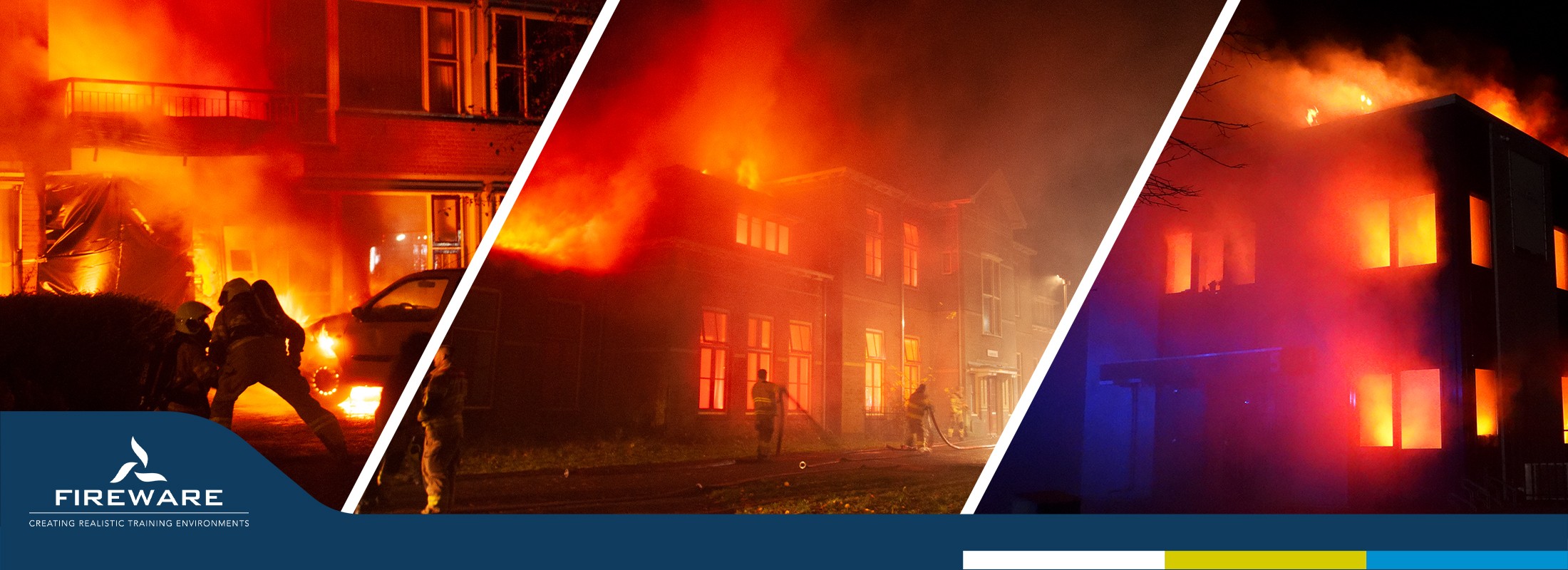

What is simulated fire?
By using light and smoke, we create a lifelike fire effect without actually setting anything on fire. This allows us to turn any location into a training environment. That means you can practice in environments that are relevant to you, whether it is the café around the corner, the local supermarket or a complex industrial site. Simulated fire makes it possible to create the most realistic and safe training environment without the use of real fire.
Why do we use simulated fire?
With simulated fire, we realistically replicate fire sources in a safe and non-destructive way. This makes it possible to conduct training anywhere, even in locations where real fire is difficult or prohibited, such as hospitals or industrial sites. It is also a clean method, as there are no residues from practice extinguishers, keeping the training environment neat at all times.
All fire response procedures can also be practiced with simulated fire. In an Workplace First Aid and Fire Safety training, for example, this includes alerting, evacuation, communication, and the use of small extinguishers. In firefighter training, a well-designed simulated environment makes it possible to practice every step: from the call and departure to reconnaissance, entry, movement, and victim rescue.
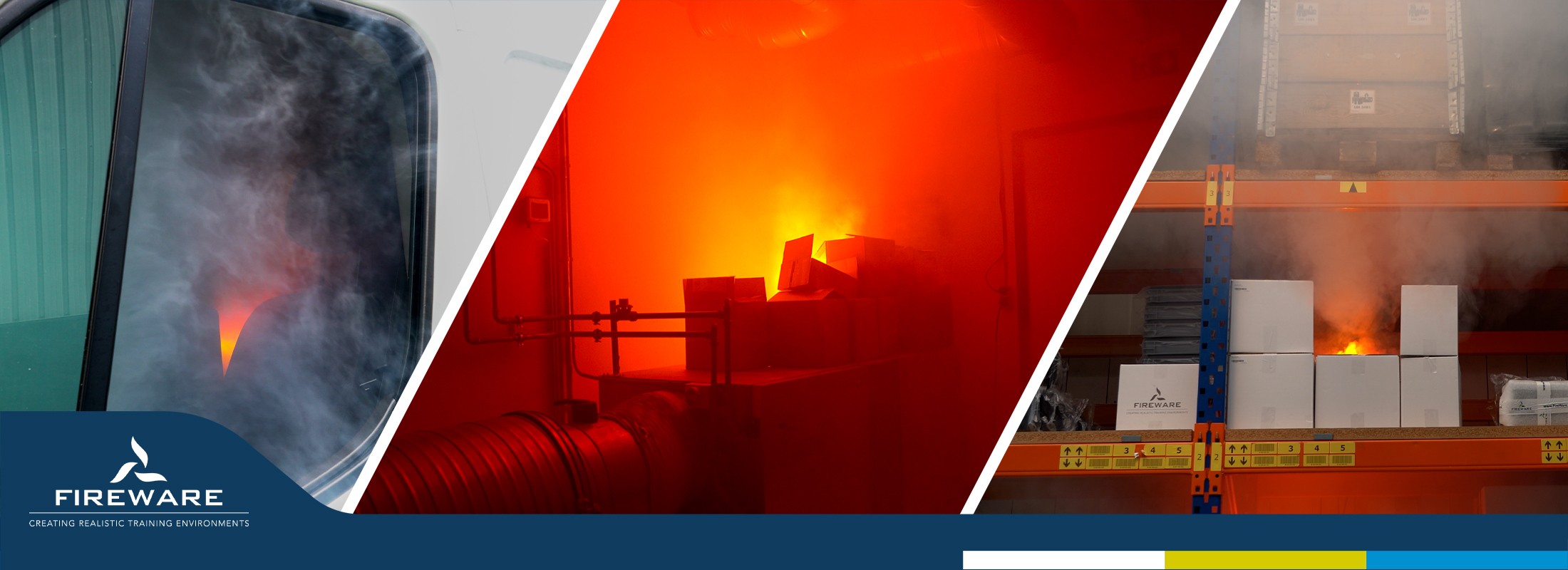

How does simulated fire work?
To answer that question, we first need to look at what real flames are. Flames are produced by a combustion reaction and are the light emitted when tiny, glowing particles are carried upward by hot air. In complete combustion, there are hardly any glowing particles, making the flames almost invisible. However, combustion is usually incomplete: unburned particles rise with the smoke and glow, which is what makes the flames visible. Simply put, flames are glowing smoke and soot particles.
We replicate the same principle using a smoke machine and a fire glow spotlight. The smoke machine allows you to place the smoke exactly where you want it. With the fire simulation spotlight, you shine light into the smoke. For example, you can use the FireSpot, such as the FireSpot MK2 or the original FireSpot, to illuminate the smoke particles. Its unique lens system creates a realistic dispersion of red and amber LEDs, producing the appearance of flames. Because it mimics the behavior of real flames, the effect looks very realistic.


Expand
These simulated fire sources form the basis of all fire simulations. Once you master this, you can create anything, from a small trash can fire to a large fire front. The principle always remains the same.
For larger scenarios, more powerful smoke machines and fire simulation spotlights are suitable. For example, you can choose the FireSpot XXL, which also allows for convincing setups in daylight. Flames can be simulated not only with fire glow spotlights but also with Silkflames. The silk fabric of the Mini Silkflame and Phoenix Silkflame, combined with the light shining through it, already creates a realistic flame effect. When used with smoke, the flames become even more convincing. You can even use the Silkflames without the flame fabric, allowing them to function as a fire glow spotlight.


Always with smoke
Smoke is required for every simulated fire source, because flames consist of glowing smoke and soot particles. Since you want to place the smoke exactly where the flames should appear, it is often wiser to use multiple small smoke machines rather than one large one. Adjust the power of the smoke machine to the environment, as an industrial hall, for example, requires more power than a living room.
If smoke cannot or may not be used, it is important to first determine whether the location is suitable for a realistic fire exercise. After all, fire without smoke does not exist. If you still want to train, focus on scenarios that fit within the possibilities, such as an external fire on the outside of the building.
Did you know that it is possible to train with dense smoke effects without using real smoke? This can be done with a blinding effect for each participant, such as with Nebula AR smoke simulation masks, which gradually limit vision. You can also choose the Black Smoke Blinding Mask or the Blindfold Mask Emergency Assistance, which provide a fixed vision-limiting effect. This way, participants can learn the correct procedures even without real smoke.
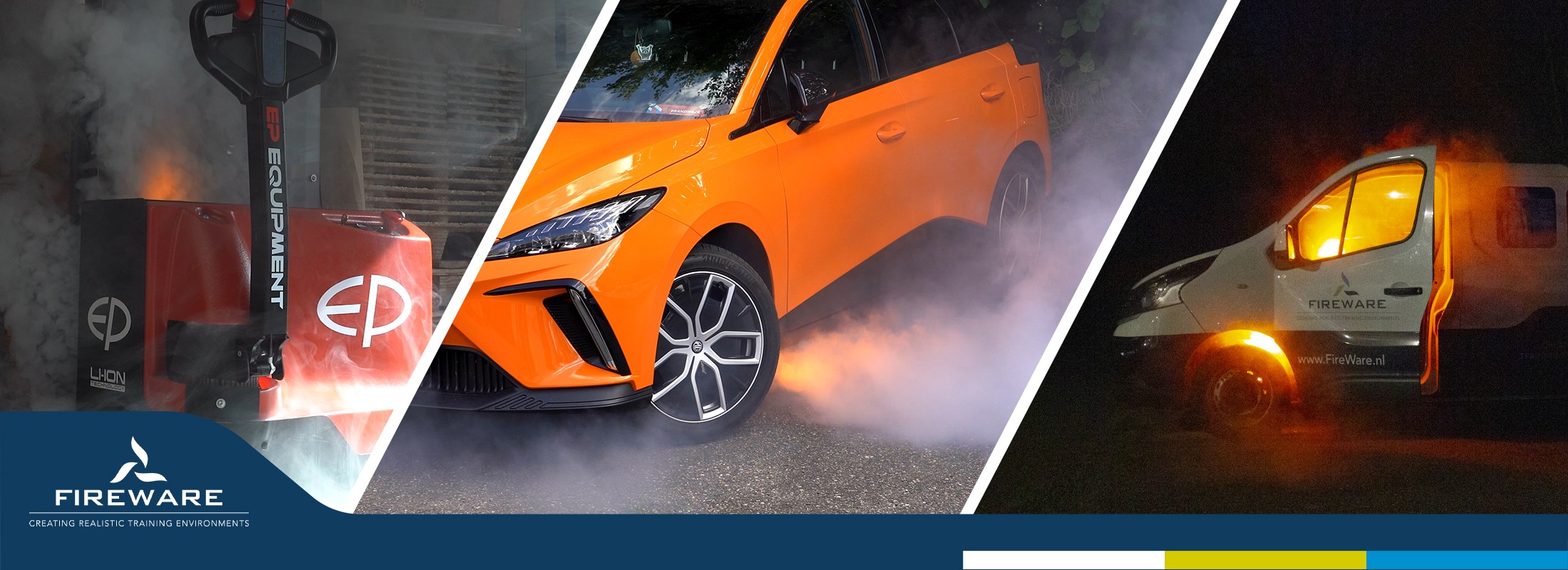

Training realistically with all your senses
With light and smoke, we create a realistic visual effect, but visuals alone are not enough. In an earlier blog, we already discussed how important it is to stimulate multiple senses. For a convincing simulation, as many senses as possible should be engaged.
Sound plays an important role in this. During a fire, it is never silent: you hear cracking, collapsing structures, and people shouting. Sound makes the scene feel lifelike. Always use ambient sound, for example with a SoundBox V3 or the Pandora’s Box 230.
Scent can also be easily added. With Burning Smell Spray or by adding Burning smell extract to the smoke fluid, the smell spreads exactly where it is needed. This allows participants to experience tension, adrenaline, and pressure, as if they were dealing with a real incident, preparing them optimally for situations that truly matter.
With these additions, the pieces of the puzzle come together. That is exactly what we aim for: preparing people for the moments that truly matter.
Seeing, hearing, and smelling are of course important, but they are not the only senses needed for a convincing simulation. Want to discover how to stimulate all the senses optimally? Be sure to check out our previous blog.
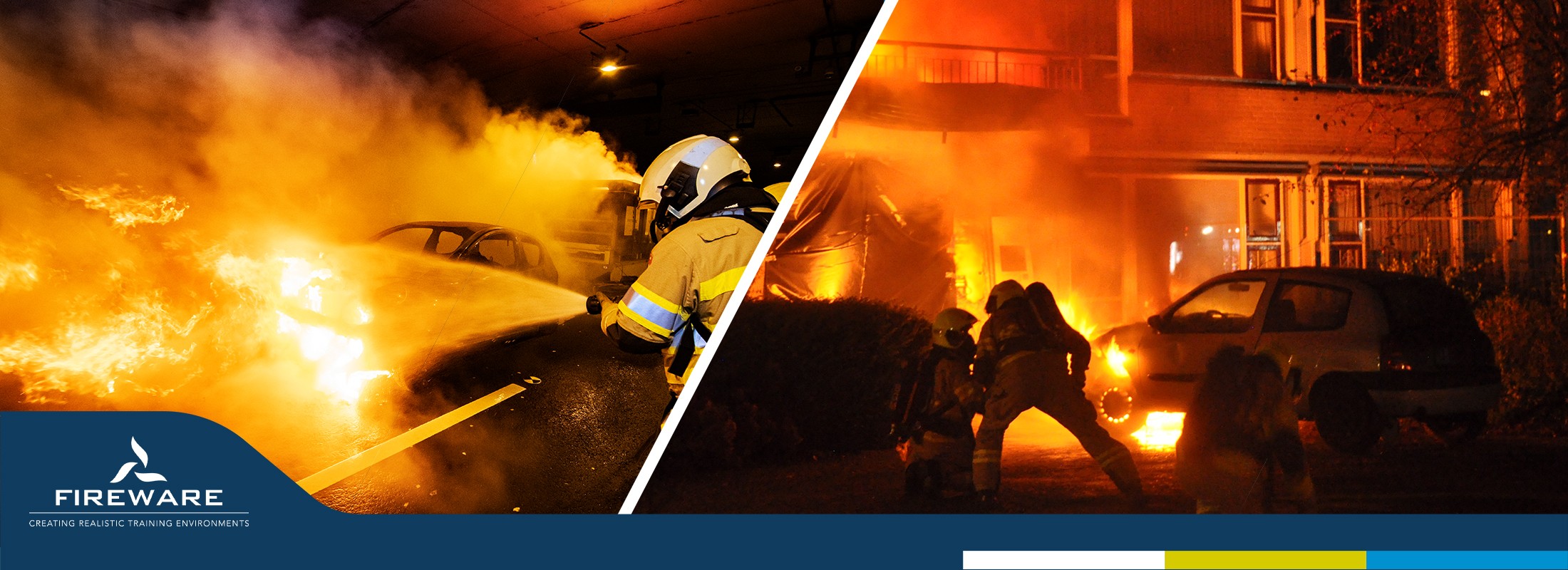

Hybrid simulation
Hybrid simulation combines simulated fire with real flames. Gas-powered fire trainers, such as the Vesta and the Hybrid, make this manageable. Real flames are unmatched: they look convincing and emit heat, engaging the skin in the experience and greatly enhancing the realism.
Although it is not always possible to work with real fire, you can use it where feasible, for example outdoors or in a suitable space. Confrontation with real flames also enhances the realism of simulated fire when it is used later.
Want to learn more about this? Discover it in our previous blog on training with real fire.
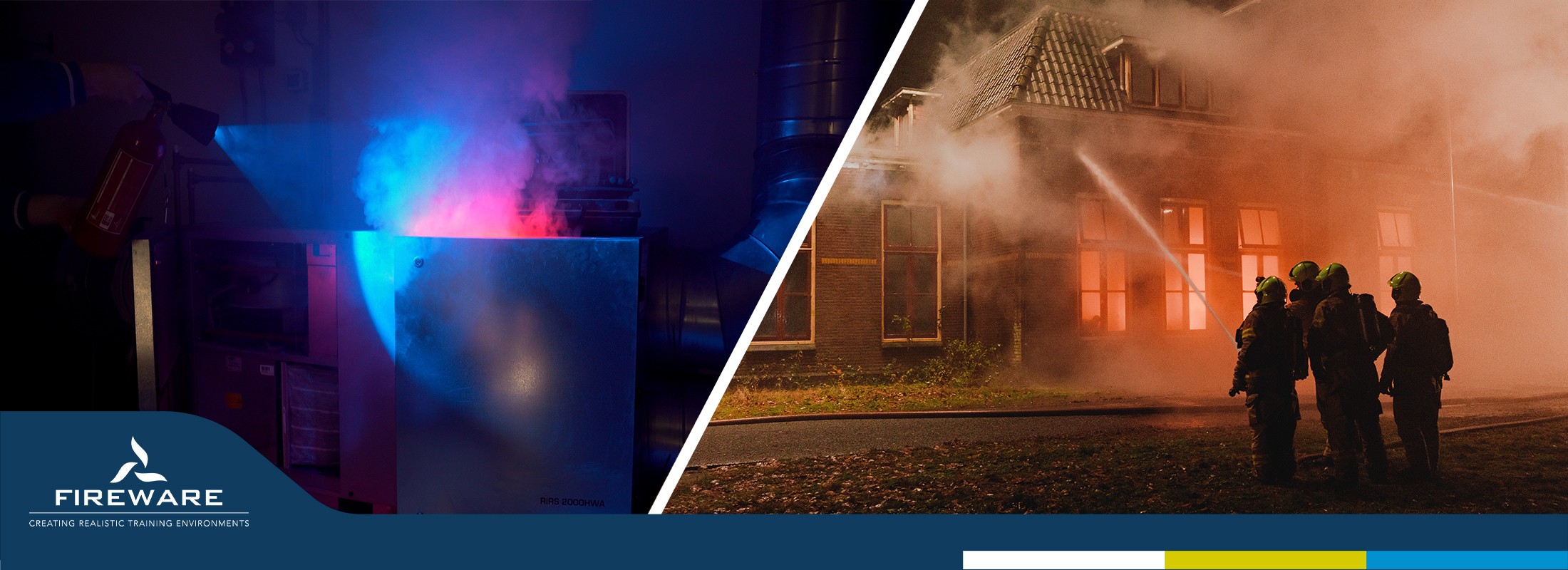

Can simulated fire sources be extinguished with water?
A frequently asked question! Our answer: it depends on your location and the materials being used.
The great advantage of simulated fire sources is that you can create a training location almost anywhere, even where water is not allowed. In such situations, you can still practice all the steps and procedures of firefighting, including extinguishing.
In this case, extinguishing happens digitally. You do not use water, but an LED beam. With the Apollo LED training fire extinguishers, you can put out fires safely and realistically: they feel like a real extinguisher, make the sound of a spraying extinguisher, and emit a blue LED from the nozzle. For an even more convincing effect, the extinguishers can be connected to the Pandora’s Box V4 or 230, making the extinguishing interactive. No water is needed, making it ideal for Workplace First Aid and Fire Safety training!
But back to the original question, “Can you not extinguish simulated fire with water?” Yes, you certainly can! The FireWare FireSpot MK2 and XXL are waterproof, and if you place the smoke machine in a safe location and channel the smoke to the FireSpot(s) with a smoke hose, you can create a fully extinguishable scenario. You can also save your extinguishing practice for another moment, for example with a (gas-powered) fire source.
In short: with the right equipment, you can extinguish simulated fire with water or opt for LED training fire extinguishers for a digital, interactive, and clean scenario.
Learn more
Creating a realistic fire source is not difficult, but a little help is always valuable. Check out our how-to videos in the Simulation Academy for step-by-step examples, or attend a Basic Realistic Staging Training. Together, we ensure more effective exercises and better-prepared responders!






